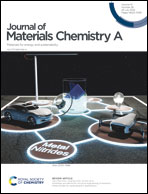Paradigm ink with a temporally controllable processing-window for perovskite modules†
Abstract
Controlling the temporal window of processing is vital for optimizing nucleation and crystal-growth. This is not only crucial to ensure a high-quality film for module application, but also important to the general compatibility of various deposition techniques. So far, controlling the crystallization either in an ultrafast (<10 s) or relatively slower (≫100 s) process has been reported in two major precursor ink systems, while a temporal gap (from 10 to 100 s) remains where multiple deposition techniques such as spin-coating would need to deliver an optimized larger-area film. Here we report a paradigm ink using a high donor number (DN) solvent such as dimethyl sulfoxide (DMSO) as an additive to a volatile non-coordinative solvent system, where the lone electron pair at the sulfinyl group can bond with the perovskite intermediate in the precursor ink. This bonding along with the low vapor pressure of DMSO reduces the supersaturation rate, eventually leading to a finely controllable solidification process from seconds to hundreds of seconds. As a result, using this ink we obtained a 15 cm2 minimodule with a power conversion efficiency (PCE) of 17.12%, and an ultra-small area-dependent efficiency drop (ADED) of −0.12% cm−2 (vs. −1.30% cm−2 for a reference ink).



 Please wait while we load your content...
Please wait while we load your content...